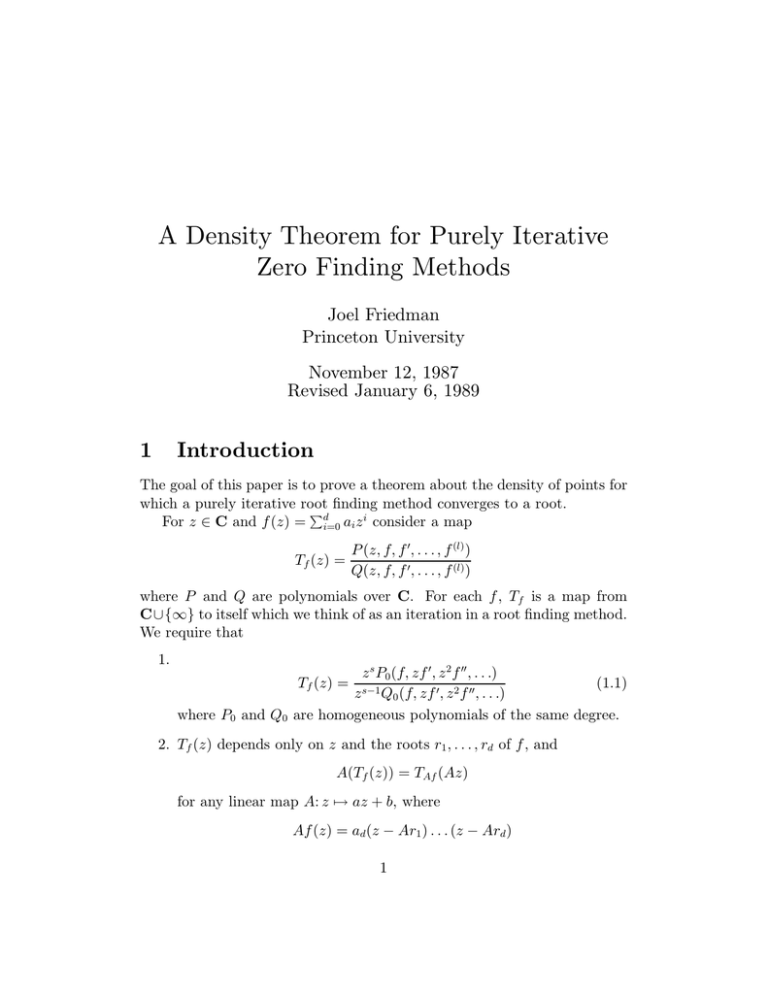A Density Theorem for Purely Iterative Zero Finding Methods 1 Introduction
advertisement

A Density Theorem for Purely Iterative
Zero Finding Methods
Joel Friedman
Princeton University
November 12, 1987
Revised January 6, 1989
1
Introduction
The goal of this paper is to prove a theorem about the density of points for
which a purely iterative root finding method converges to a root.
P
For z ∈ C and f (z) = di=0 ai z i consider a map
Tf (z) =
P (z, f, f 0, . . . , f (l) )
Q(z, f, f 0, . . . , f (l))
where P and Q are polynomials over C. For each f , Tf is a map from
C∪{∞} to itself which we think of as an iteration in a root finding method.
We require that
1.
z s P0 (f, zf 0 , z 2 f 00 , . . .)
Tf (z) = s−1
(1.1)
z Q0 (f, zf 0, z 2 f 00, . . .)
where P0 and Q0 are homogeneous polynomials of the same degree.
2. Tf (z) depends only on z and the roots r1 , . . . , rd of f , and
A(Tf (z)) = TAf (Az)
for any linear map A: z 7→ az + b, where
Af (z) = ad (z − Ar1 ) . . . (z − Ard )
1
for
f (z) = ad (z − r1 ) . . . (z − rd ).
3. Tf (r) = r, |Tf0 (r)| < 1 for any root r of f .
4. Tf (∞) = ∞, |Tf0 (∞)| > 1 for any f of degree > 1.
To measure the density of convergent points for Tf , let Pd denote the
polynomials of degree d with roots in the unit ball. For a polynomial f , let
ΓT,f = {z : Tfn (z) → a root of f as n → ∞}
where Tfn is the n-th iterate of Tf (i.e. ΓT,f is the set of points converging
to a root of f under the iteration Tf ). Let
AT,f = |ΓT,f ∩ B2 (0)| .
Then AT,f /4π is the probability that a random point in B2 (0) converges to
a root.
Theorem 1.1 Let T satisfy (1)-(4). Then for any d there is a c > 0 such
that
AT,f > c
∀f ∈ Pd .
Furthermore, we have
AT,f,r > c
∀f ∈ Pd ,
∀r with f (r) = 0,
where AT,f,r denotes the contribution to AT,f from the root r of f .
More precisely,
AT,f,r = |ΓT,f,r ∩ B2 (0)|
where
ΓT,f,r = {z : Tfn (z) → r as n → ∞}
The above density theorem was conjectured to hold for Newton’s method
by Smale in [Sma85]. This conjecture was proven in [Fri86]; the proof used
some special properties of Newton’s method and explicit bounds on the
constants as a function of d were given. The above theorem applies to a
much larger class of root finding methods, though no explicit bounds on c
are given.
Examples of T satisfying (1)-(4) are
2
1. Newton’s method, Tf (z) = z −
f
.
f0
2. Modified Newton’s method, Tf (z) = z − h ff0 with a constant h, 0 <
h < 1.
3. Taylor’s method (see [Atk78])
Tf (z) = z +
k
X
di
i=1
φt (z)
i!
dti
!
hi
t=0
where φt (z) solves
dφt (z)
f (z)
=− 0 ,
dt
f (z)
φ0 (z) = z
with k a positive integer and h a positive number sufficiently small
(depending on k).
4. Incremental Euler’s method (see [Atk78])
Tf (z) = z +
k
X
(−hf (z))k
i=1
k!
g (k)(f (z))
with g = f −1 , k a positive integer, and h positive and sufficiently
small.
5. Any iterate of a T satisfying (1)-(4). This shows that maps satisfying
(1)-(4) may contain extraneous attractive fixed points. For example,
Newton’s method, even applied to polynomials of degree as low as
three, can contain attractive periodic points of period two. Therefore
the second iterate of Newton’s method can have extraneous attractive
fixed points.
To prove theorem 1.1, take any sequence fn ∈ Pd ; we will show that AT,fn
can not approach 0 as n tends to infinity. By passing to a subsequence we
can assume each of the fn ’s coefficients, or equivalently each of fn ’s roots,
converge. If AT,f were continous in f at the limit of the fn ’s then we would
be done; the fact that AT,f can be discontious at f ’s having multiple roots
makes the theorem more interesting. If the limit of fn has at least one
3
isolated root, one would get enough of a contribution to AT,fn from such
an isolated root (for large n) to show that AT,fn is bounded away from
zero. However, if all of fn ’s roots tend to cluster into several groups as
n → ∞, we must look at the limiting geometry of each individual cluster
to estimate AT,fn . So fix a cluster, and“blow-up” the picture of the roots
at that cluster so that, while they remain in some bounded region, they
separate into smaller subclusters. Again, if the blow-up of at least one
cluster has as least one isolated root, we are done; the reason is that the
isolated root’s contribution to ΓT,fn contains a sequence of balls which, from
the point of view of the subcluster, tend to ∞ and whose radii get larger.
These balls, from the point of view of the original scale of the problem,
look like a sequence of balls whose radii get smaller and smaller and whose
center converges to the cluster’s limit point. It is not hard to see that in
the original scale of the problem, the largest ball is of appreciable size, thus
bounding AT,fn from below.
If none of the clusters has an isolated root, we look at the geometry
of each subcluster, blowing-up the picture at each subcluster. Since the
blowing-up process separates a cluster of roots into at least two distinct
subclusters, successive blowing-up eventually isolates the roots. One can
then find balls in ΓT,fn for each root in the blow-up of the picture which
isolates it, and back-up through the blow-ups until reaching the original
scale of the problem, finding balls in each scale of blow-up which lie in
ΓT,fn . The fact that this can be done for each root proves, in addition, the
second part of the theorem.
The basic estimate for the existence of the aforementioned balls is
lemma 2.2, proved in section 2. In section 3 we describe the blowing-up
process more precisely, and show how lemma 2.2 can be applied backwards
through the blowing-up process.
2
Some Preliminary Results
Let g: N → C∪{∞} be a complex analytic map, for an open N ⊂ C∪{∞}.
Let z ∈ N be a repelling fixed point, i.e. g(z) = z and |g 0(z)| > 1.
Lemma 2.1 For any open A ⊂ C we have that for n sufficiently large,
g n {B (z)} ∩ A 6= ∅.
4
Proof Apply Cauchy’s formula for (f g n)0 (z), where f is a Möbius function
taking a point in A to ∞, and where the contour is a small circle around z.
For our maps T , we have that ∞ is a repelling fixed point so the lemma
can be applied.
From condition (1)-(4) on T it is easy to see that
Tf0 (∞) = q(d) =
Q0 (1, d, d(d − 1), . . .)
P0 (1, d, d(d − 1), . . .)
is a rational funciton of d independent of f , and that if r is a k-tuple root,
then
P0 (1, k, k(k − 1), . . .)
1
Tf0 (r) =
=
.
Q0 (1, k, k(k − 1), . . .)
q(k)
For any f we have that for z in a neighborhood of ∞,
Tf (z) =
and
Tf0 (z)
z
+ O(1)
q(d)
1
1
+O
=
q(d)
|z|
!
(2.1)
and Tf−1 is defined locally. We have
Tf (z)
1
1
=
+O
z
q(d)
|z|
!
and so for |z| sufficiently large, we have z0 = z, z−1 , z−2 , . . . given by Tf (z−i ) =
z−i+1 has |z−n | growing like (q(d) − )n for any > 0 depending on how
large |z| is, and thus
n−1
Y
z−n
1
1−O
=
z
|z−i |
i=0
!!
1
= q (d) 1 − O
|z|
n
5
q(d)
!!
.
(2.2)
The mean value theorem and equation 2.1 yield for, say, r < |z|/2,
Tfn {Br0 (z−n )} ⊂ Br (z)
(2.3)
with
r0
1
1
= r q n (d) 1 − O
+···+
|z−n+1 |
|z|
!!
1
= r q n (d) 1 − O
.
|z|
Let
!!
(2.4)
z−n
,
n→∞ q n (d)
z̃ = lim
the limit existing by virtue of equation 2.2. For any r < |z|/2, using
equations 2.3 and 2.4, we have
n
o
Tfn Brqn (d)/2 (z̃q n (d)) ⊂ Br (z)
(2.5)
for n sufficiently large (depending on r).
Next we would like to obtain a version of equation 2.5 for polynomials
close to f in a certain sense. Fix d, D, and f , and consider the set Ff,δ,D
of polynomials
g(z) = (z − s1 ) . . . (z − sd+D )
with si ∈ Bδ (ri ) for 1 ≤ i ≤ d and |si| > 1/δ for i > d.
Lemma 2.2 For any sufficiently large z and r < |z|/2 there is a c, δ0 and
n0 such that if δ < δ0 and n > n0 we have
n
o
Tgn Brqn (d)/2 (z̃q n (d)) ⊂ Br (z)
if
|z̃|q n (d) <
for all g ∈ Ff,δ,D .
6
c
δ
Proof Dividing both numerator and denominator by z s−1 g deg(P0 ) in condition (1) on T yields
0
Tg (z) =
0
≤
d X
i=1
=
00
Q0 (1, z gg , z 2 gg , . . .)
For |z| sufficiently large and, say, ≤
f0
g 0 − f
g
00
zP0 (1, z gg , z 2 gg , . . .)
1
2δ
.
we have
d+D
X 1 1
1 −
+
z − ri z − si j=d+1 z − sj X
X s i − ri
1
+
(z − ri )(z − si ) |z − si |
!
= O
δ
+δ .
|z|2
Similarly we have
f (k)
g (k) −
f
g 1
1
−
≤
k! +
(z − ri ) . . . (z − ri )
(z
−
s
)
.
.
.
(z
−
s
)
i
i
1
1
k
k
1≤i1 <...<ik ≤d
X
1
k! (z − si ) . . . (z − si ) 1
k
1≤i1 <...<ik ≤d+D, ik >d
!
X
δ
δ
δ2
+
+
+ · · · + δk
|z|k+1 |z|k−1 |z|k−2
!
δ
δ
= O
+
;
|z|k+1 |z|k−1
= O
in the last line we have used the fact that for sufficiently large z and n we
have |z|δ < 1 (which follows from the second equation in the statement of
the lemma). Thus
(k) f (k)
k
kg
−z
z
=O
f
g and so
δ
+ δ|z|
|z|
!
!!
δ
Tg (z) = Tf (z) 1 + O
+ δ|z| ,
|z|
!!
δ
0
0
Tg (z) = Tf (z) 1 + O
+ δ|z| .
|z|
7
(2.6)
We caution the reader that the big-O notation above is as the quantity
in parenthesis tends to zero, and that the constants in the big-O notation
depend on d and D. Now fix a z sufficiently large and a small so that
z0 = z, z−1 , z−2 , . . . defined as before grow like a geometric series. Then,
using equation 2.6, we see that for δ sufficiently small we have that y0 =
z, y−1 , y−2 , . . . , y−n given by Tg (y−i ) = y−i+1 grows like a geometric series,
as long as |y −n | < c/δ for c sufficiently small. Then we get
y−n = z−n
n−1
Y
i=0
= z−n
δ
+ δ|y−i |
1+O
|y−i |
δ
+ δ|y−n |
1+O
|z|
!!
!!
.
Using the chain rule we have
(Tgn )0 (w) =
n−1
Y
Tg0 (Tgi (w))
i=0
1
q(d)
=
!n
δ
1+O
+ δ|w|
n
|Tg (w)|
!!
assuming |Tgn (w)| is sufficiently large and |w| ≤ c/δ. The mean value theorem then implies
Tgn {Br0 (z−n )} ⊂ Br (z)
where
δ
+ δ|z−n |
r 0 = rq n (d) 1 + O
|z|
!!
.
Hence, as before, we get that for sufficiently large n,
n
o
Tgn Brqn (d)/2 (z̃q n (d)) ⊂ Br (z)
as long as |z̃|q n (d) <
3
c
δ
for c sufficiently small.
Successive Normalizations
The difficulty in proving theorem 1.1 is that AT,f is not necessarily continuous when f has multiple roots. Let f1 , f2 , . . . be a sequence in Pd , and
8
r11 , r12 , . . . a sequence of respective roots for which
lim AT,fn ,r1n =
n→∞
inf
f ∈Pd , f (r)=0
AT,f,r .
By passing to a subsequence we may assume that
fn (z) = (z − r1n )e1 . . . (z − rkn0 )ek0
with
e1 + · · · + ek0 = d
and
rin 6= rjn
∀n,
i < j ≤ k0 .
By passing to a subsequence we can assume
rin → ri
as n → ∞.
If r1 is isolated, i.e. e1 = 1, then it would be easy to show that for some
δ > 0 we have
Bδ (rin ) ⊂ ΓT,fn
for all n sufficiently large, and thus
inf
f ∈Pd , f (r)=0
AT,f,r > 0
(the details of the argument appear as part of the proof later in this section).
If not, we can assume
r1 = r2 = . . . = rk 1
and rj 6= r1 for j > k1 . We will now analyze more carefully the way in
which r1n , . . . , rkn1 converge to r1 .
For z1 , . . . , zm ∈ C not all the same, we define the normalization of
z1 , . . . , zm centered at z1 to be the unique linear map
g(z) = az + b,
such that
X
a ∈ R, a > 0, b ∈ C
|g(zi) − g(zj )| = 1,
i<j
and g(z1) = 0.
By passing to a subsequence we can assume that
9
1. the normalizations of r1n , . . . rkn0 , gn (z) = an z + bn , centered at r1n have
gn (rin ) → si as n → ∞, and
2.
b− logq1 an c
q1
an → a
(3.1)
as n → ∞ for some a ∈ [1/q1 , 1] where
q1 = q
k1
X
ei
i=1
and where bβc denotes the largest integer ≤ β.
Clearly
X
|si − sj | = 1,
i<j
and so we have
s1 = · · · = sk2
and sj 6= s1 for j > k2 where k2 < k1 . In other words, by normalizing we
separate the first k1 roots into smaller groups. By repeated normalization
we will finally separate r1n from all other rin ’s. Now we start with the deepest
level of normalization and work up, proving a density lower bound for each
level.
Let the deepest level be `, and let
hn (rin ) → ti
for 1 ≤ i ≤ k`
where hn is the normalization of r1n , . . . , rkn` centered at r1n . We have
X
|ti − tj | = 1,
i<j
t1 = 0, and ti 6= t1 if i > 1. Consider
f˜(z) = (z − t1 )e1 . . . (z − tk` )ek` .
Since Tf˜(t1 ) = t1 , |Tf0˜(t1 )| < 1, and ∞ is a repelling fixed point for Tf˜ we
have open sets E, arbitrarily near ∞, such that Tfn˜ {E} → t1 as n → ∞.
Take a point z large enough so that lemma 2.2 holds, with B (z) converging
10
to t1 uniformly under Tf˜ for some > 0 (we can assure uniform convergence
by assumption (3) of section 1). We have
Bq`m /2 (z̃q`m ) ⊂ ΓT,f˜
for m sufficiently large where z̃ is as in lemma 2.2 and
q` = q
k
X̀
ei .
i=1
Let h0n be the normalization of the `−1-th level, i.e. of r1n , . . . , rkn`−1 centered
at r1n ,
h0n (z) = a0n z + b0n
and let
hn (z) = an z + bn .
We have that
an b− logq` (an /a0n )c
q
→a
a0n `
as n → ∞ for some a ∈ [ q1` , 1] (at each level we normalize and pass to a
subsequence satisfying a condition analogous to that of equation 3.1 as well
as the preceeding condition). We want to prove that
B0 (z0 ) ⊂ ΓT,h0n fn
(3.2)
for all sufficiently large n, where
z0 = z̃aq`−M
0 = aq`−M /4
for some positive integer M ; this will complete the first stage moving backwards through the normalizations, each time finding a ball of fixed size
with respect to the current normalization in ΓT,fn for sufficiently large n.
To prove equation 3.2, consider first
hn fn (z) = (z − hn (r1n ))e1 . . . (z − hn (rkn` ))ek` .
We claim that for n sufficiently large we have
B (z) ⊂ ΓT,hn fn .
11
To see this, we note that for some small η > 0 we have
|z − t1 | ≤ η =⇒ |Tf˜(z) − t1 | ≤ (1 − µ)|z − t1 |,
by assumption (3) of section 1, for some µ > 0, and that for some large N ,
TfN
˜ {B (z)} ⊂ Bη/2 (t1 )
by the uniform covnergence. Estimating as in lemma 2.2 (note that for any
δ we have hn fn ∈ Ff˜,δ,D for n sufficiently large and D = d − q` ) we get that
for n sufficiently large
|z − t1 | ≤ η =⇒ |Thn fn (z) − t1 | ≤ (1 − µ/2)|z − t1 |
=⇒ z ∈ ΓT,hn fn
and that
ThNn fn {B (z)} ⊂ Bη (t1 ) ⊂ ΓT,hn fn
using hn (r1n ) = t1 and that for any y ∈ B (z) we have y, Tf˜(y), Tf˜2(y), . . .
stays away from the rin ’s with i > 1. Now we apply lemma 2.2 to conclude
that for m sufficiently large we have
n
o
Thmn fn Bq`m/2 (z̃q`m ) ⊂ B (z) ⊂ ΓT,hn fn
so that
Bq`m /2 (z̃q`m ) ⊂ ΓT,hn fn
as long as |z̃|q`m < c/δ for some c sufficiently small, where 1/δ is a lower
bound on hn (rin ) for i > k` . Rescaling by a factor of an /a0n and translating
appropriately we get
Bq`m an /(2a0n ) (z̃q`m an /a0n ) ⊂ ΓT,h0n fn
if
|z̃|q`m an /a0n < c min h0n (rin ) < c0 .
i>k`
Taking
m(n) = blogq`
12
a0n
c−M
an
(3.3)
where M is sufficiently large to ensure equation 3.3 holds, we get that for
sufficiently large n,
Baq−M /4 (z̃aq`−M ) ⊂ ΓT,h0n f ,
`
the 4 in
aq`−M /4
appearing to account for the fact that
an m(n)
q
a0n `
approaches, rather that equals, aq`−M as n → ∞. Thus equation 3.2 is
established.
Now that we have a statement of the form
B0 (z0 ) ⊂ ΓT,h0n fn ,
we proceed to get a statement of the form
B1 (z1 ) ⊂ ΓT,h00n fn ,
where h00n is the normalization at the ` − 2-th level, i.e. the normalization
of r1n , . . . , rkn`−2 centered at z1n . To do this we consider
fˆ(z) = (z − t1 )e1 . . . (z − tk`−1 )ek`−1 .
Using lemma 2.1 we can find an arbitrarily large z with an so that for
some N
n
o
TfN
B/2 (z) ⊂ B0 (z0 ).
ˆ
Now we repeat the argument of before to conclude
ThN0n fn {B (z)} ⊂ B0 (z0 )
i.e.
B (z) ⊂ ΓT,h0n fn
(with uniform convergence) for n sufficiently large, and that
m0 (n)
Th00n fn {B1 (z1 )} ⊂ ΓT,h00n fn
(again with uniform convergence) for some m0 (n) and fixed 1 , z1 .
13
Repeating the above argument ` − 2 more times yields that for all n
sufficiently large we have
B (z) ⊂ ΓT,fn
for some fixed and z with z very near r1n . Hence
lim AT,fn ,r1n > π2 > 0
n→∞
and theorem 1.1 is proven.
References
[Atk78] K. Atkinson. An Introduction to Numerical Analysis. Wiley, New
York, 1978.
[Fri86]
Joel Friedman. On the convergence of newton’s method. In
27th Annual Symposium on Foundations of Computer Science,
pages 153–161, 1986.
[Sma85] Steve Smale. On the efficiency of algorithms of analysis. Bull. of
the AMS, 13(2):87–121, Oct. 1985.
14





